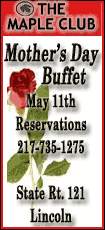|
 The Commerce Department reported Thursday that consumer spending was up 0.4 percent, double the increase that economists had forecast. However, once inflation was removed, spending edged up a much slower 0.1 percent. The Commerce Department reported Thursday that consumer spending was up 0.4 percent, double the increase that economists had forecast. However, once inflation was removed, spending edged up a much slower 0.1 percent.
The March reading was the fourth straight lackluster performance and did nothing to alleviate worries that consumer spending, which accounts for two-thirds of total economic activity, remains under severe strains, reflecting an economy beset by multiple problems.
Rising food costs, soaring energy prices and rising unemployment have pushed consumer confidence to the lowest levels in five years. Incomes in March rose a weak 0.3 but after removing inflation, after-tax incomes were flat.

The Bush administration is counting on its $168 billion stimulus program to give the economy enough of a lift to keep the country from slipping into a full-blown recession, but private economists are worried that the boost could well be fleeting.
"Consumers are facing bad news on all fronts," said Nigel Gault, chief U.S. economist at Global Insight. "Any burst of spending based on the stimulus payments is likely to prove short-lived."
Sal Guatieri, senior economist at BMO Capital Markets, said economic growth could still turn negative this quarter even with the rebates. He cited a recent Associated Press-Ipsos poll that found only 19 percent of people plan to spend their rebates, with others surveyed preferring instead to use the $600 to $1,200 checks for the typical family to pay off bills or boost savings.
Guatieri said he expected the rebate checks to be a "moderate tonic," but he cautioned that once the rebates are spent, growth could turn negative later this year.

On Wall Street, investors brushed aside weak economic reports to focus instead on a rebound in the dollar's value against other currencies and falling oil prices. The Dow Jones industrial average surged 189.87 points to close at 13,010.00, the first close above 13,000 since Jan. 3.
The government reported Wednesday that the overall economy, as measured by the gross domestic product, eked 0.6 percent growth in the first three months of this year, weak but still in positive territory. Much of the drag in the first quarter came from a tiny 1 percent growth in consumer spending, the weakest increase since the economy was last in recession in 2001.
[to top of second column] |
 Some analysts are worried that the GDP could turn negative this quarter if there is a significant cutback on production by businesses trying to work off excess inventories and if consumers grow more glum in the face of continued increases in unemployment.
The Labor Department reported Thursday that jobless claims jumped by a bigger-than-expected 35,000 last week to total 380,000 with the number of people receiving benefit checks rising to 3.02 million, the first time that figure has surpassed 3 million in four years.
The department will release the unemployment figure for April on Friday. Economists expect it will show the jobless rate rising to 5.2 percent, up from 5.1 percent in March, with the economy shedding jobs for a fourth straight month.

In other signs of economic stress, the Commerce Department said Thursday that construction spending fell 1.1 percent in March with housing activity plunging by a record 4.6 percent, indicating that builders are still cutting back sharply in the face of the worst slump in housing in more than two decades.
A closely watched gauge of manufacturing activity from the Institute of Supply Management activity posted a reading of 48.6 for April, indicating that manufacturing remained in recession territory. Analysts said without strength in export sales coming from the weaker dollar, the decline in manufacturing would be much worse.
The Federal Reserve on Wednesday cut a key interest rate for the seventh time in the past eight months, although the quarter-point move may prove to be the last rate cut because of Fed worries about rising inflation pressures.
On the inflation front, a price gauge tied to consumer spending rose by 0.3 percent in March, triple the 0.1 percent rise in February. Much of that jump reflected higher food and energy costs. Core inflation, which excludes those categories, rose by 0.2 percent in March and is up 2.1 percent over the past 12 months, higher than the Fed's 1 percent to 2 percent comfort zone.
[Associated Press; By MARTIN CRUTSINGER]
Copyright 2008 The Associated Press. All rights reserved. This
material may not be published, broadcast, rewritten or
redistributed. |